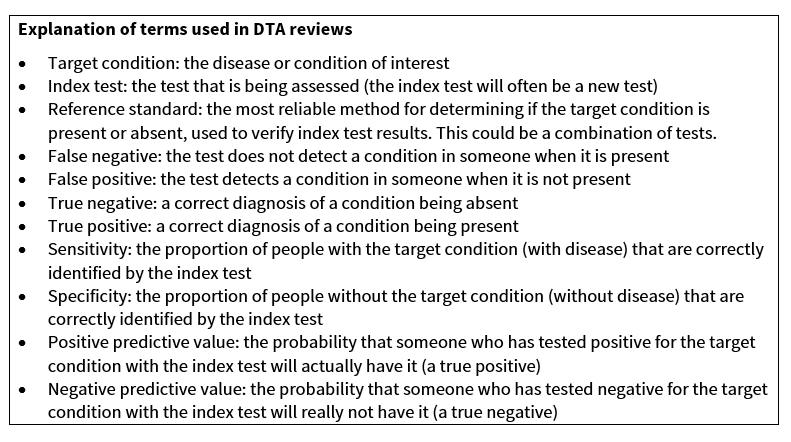
Cochrane systematic reviews can help us to make healthcare decisions based on up-to-date research evidence. They are systematic because they search for and analyse evidence in a systematic way, according to predetermined and published methods. Each systematic review answers a specific healthcare question by gathering all the relevant studies, assessing the reliability of these studies, then summarising their results to produce a summary of all of the available evidence.
One type of systematic review is a diagnostic test accuracy (DTA) review. In addition to investigating test accuracy, they ideally also investigate why the results may vary among studies, compare the performance of alternative tests, and help the reader to put the evidence in a clinical context. Watch the video below and read on to learn more about DTA reviews.
Cochrane DTA reviews are a type of systematic review that aim to evaluate the accuracy of diagnostic tests. They want to find out whether a new test is more accurate than an existing test, or whether it is quicker, cheaper or easier to perform. Answers to these questions help patients and healthcare workers make informed decisions about which test to use, based on up-to-date evidence.
DTA reviews evaluate how well diagnostic tests (index tests) identify or exclude a particular disease or condition (the target condition). We know that diagnostic tests make errors, even when they are correctly performed. There are two types of test errors: false positive test errors (the index test suggests the target condition is present when it is not) and false negative test errors (the test suggests the target condition is absent when it is not). Cochrane DTA reviews can cover all types of diagnostic tests, from antibody tests to X-rays, for any disease or condition. It is really important that diagnostic tests provide accurate results so that people can receive prompt treatment or take preventive measures if necessary, and to avoid unnecessary testing, treatment and anxiety.
DTA reviews search for all relevant test accuracy studies, appraise the studies for reliability, and combine their results. This gives the best possible estimate of the accuracy of an index test based on all the available evidence. DTA reviews are systematic because they search for and analyze evidence in a systematic way, according to predetermined and published methods.
Test accuracy studies most often report accuracy using sensitivity and specificity.
- Sensitivity means the proportion of people with the target condition who are correctly detected by the index test.
- Specificity means the proportion of people without the target condition who are correctly identified by the index test.
Therefore, the nearer the sensitivity and specificity are to 100%, the better the test.
An alternative way to report test accuracy is using positive and negative predictive values, which tell us about the usefulness of a positive index test result and a negative index test respectively – this helps patients understand how reliable their test results are. Predictive values measure the number of positive index test results that will be true positives and the number of negative index test results that will be true negatives. The nearer the positive and negative predictive values are to 100%, the better the test.

- View Cochrane DTA training for authors
- Visit the Cochrane Screening and Diagnostic Test Methods group website
- Read the Students 4 Best Evidence blog post 'Diagnostics Studies: how to get started with appraising the evidence'
- Learn more: What is the difference between a Cochrane systematic review of interventions and a Cochrane diagnostic test accuracy review?

